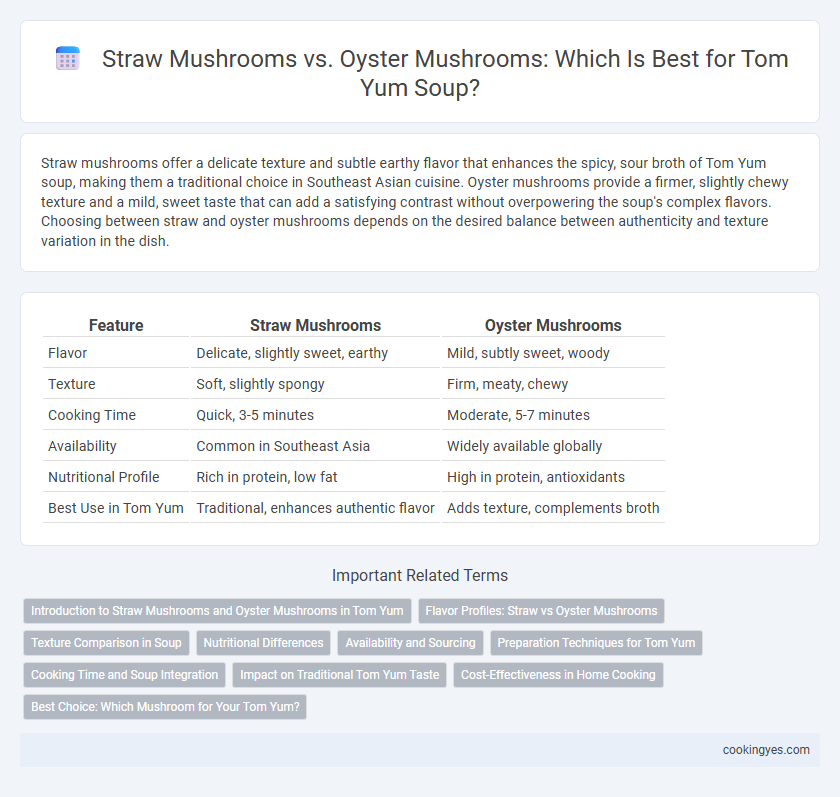Straw mushrooms offer a delicate texture and subtle earthy flavor that enhances the spicy, sour broth of Tom Yum soup, making them a traditional choice in Southeast Asian cuisine. Oyster mushrooms provide a firmer, slightly chewy texture and a mild, sweet taste that can add a satisfying contrast without overpowering the soup's complex flavors. Choosing between straw and oyster mushrooms depends on the desired balance between authenticity and texture variation in the dish.
Table of Comparison
| Feature | Straw Mushrooms | Oyster Mushrooms |
|---|---|---|
| Flavor | Delicate, slightly sweet, earthy | Mild, subtly sweet, woody |
| Texture | Soft, slightly spongy | Firm, meaty, chewy |
| Cooking Time | Quick, 3-5 minutes | Moderate, 5-7 minutes |
| Availability | Common in Southeast Asia | Widely available globally |
| Nutritional Profile | Rich in protein, low fat | High in protein, antioxidants |
| Best Use in Tom Yum | Traditional, enhances authentic flavor | Adds texture, complements broth |
Introduction to Straw Mushrooms and Oyster Mushrooms in Tom Yum
Straw mushrooms (Volvariella volvacea) are a classic ingredient in Tom Yum, prized for their tender texture and mild, slightly earthy flavor that absorbs the soup's spicy and sour broth well. Oyster mushrooms (Pleurotus ostreatus) offer a firmer texture and subtle seafood-like taste, adding a rich umami depth to Tom Yum variations. Both mushrooms complement the aromatic lemongrass, kaffir lime leaves, and galangal, enhancing the soup's complex flavor profile while catering to different textural preferences.
Flavor Profiles: Straw vs Oyster Mushrooms
Straw mushrooms offer a delicate, earthy flavor with a subtle sweetness that enhances the tangy and spicy notes of Tom yum soup without overpowering other ingredients. Oyster mushrooms provide a mild, slightly woody taste and a firmer texture that adds a hearty depth and umami richness to the broth. Choosing straw mushrooms results in a lighter, more traditional Thai flavor, while oyster mushrooms contribute a robust and savory profile ideal for a more filling soup.
Texture Comparison in Soup
Straw mushrooms offer a tender, slightly chewy texture that absorbs the rich, spicy flavors of Tom Yum broth, enhancing the soup's complexity without overpowering it. Oyster mushrooms provide a meatier, more fibrous bite, adding a satisfying heartiness and a subtle earthy flavor that complements the lemongrass and kaffir lime leaves. Choosing between straw and oyster mushrooms affects the soup's texture profile, with straw mushrooms creating a delicate mouthfeel and oyster mushrooms lending a robust, substantial texture.
Nutritional Differences
Straw mushrooms contain higher levels of antioxidants and vitamin D, making them beneficial for immune support and bone health in Tom Yum soup. Oyster mushrooms provide more protein and dietary fiber, contributing to muscle repair and digestive health. Incorporating either mushroom enhances the soup's nutritional profile with unique vitamins and minerals.
Availability and Sourcing
Straw mushrooms are widely available in Southeast Asian markets and often preferred for authentic Tom Yum soup due to their tender texture and distinct flavor. Oyster mushrooms are more commonly found in Western grocery stores and offer a meatier texture but a milder taste. Sourcing straw mushrooms can be challenging outside Asia, while oyster mushrooms provide a readily accessible alternative for Tom Yum preparation globally.
Preparation Techniques for Tom Yum
Straw mushrooms require gentle rinsing to remove dirt and should be sliced thinly to absorb the tom yum broth's robust flavors quickly. Oyster mushrooms need to be torn into smaller, uniform pieces to ensure even cooking and maintain their delicate texture in the hot, spicy soup. Both mushrooms benefit from brief simmering to retain their firmness while infusing the tom yum with their unique earthy notes.
Cooking Time and Soup Integration
Straw mushrooms cook quickly, typically within 5 minutes, releasing a subtle earthiness that blends seamlessly into Tom yum broth without overpowering other ingredients. Oyster mushrooms require a slightly longer cooking time, around 7-10 minutes, which allows their delicate texture and mild flavor to integrate fully into the soup, enhancing its umami depth. Choosing between straw and oyster mushrooms affects the overall cooking rhythm and flavor balance, with straw mushrooms offering faster infusion and oyster mushrooms providing a richer consistency.
Impact on Traditional Tom Yum Taste
Straw mushrooms contribute a delicate, earthy flavor and tender texture that enhance the authentic depth of traditional Tom Yum soup, complementing the soup's signature spicy and sour profile. Oyster mushrooms have a milder taste and slightly firmer texture, which can mellow the bold flavors and alter the classic balance of Tom Yum. Using straw mushrooms preserves the traditional taste more effectively, maintaining the soup's characteristic aroma and flavor complexity.
Cost-Effectiveness in Home Cooking
Straw mushrooms are more cost-effective than oyster mushrooms for Tom Yum soup due to their lower price and quicker cooking time, aligning well with budget-conscious home cooks. Oyster mushrooms offer a richer texture and umami flavor but come at a higher cost, making them less economical for everyday use. Choosing straw mushrooms optimizes both flavor and affordability without compromising the traditional taste of Tom Yum.
Best Choice: Which Mushroom for Your Tom Yum?
Straw mushrooms offer a delicate texture and subtle earthiness that complements the spicy, sour profile of Tom Yum without overpowering it, making them the traditional and preferred choice in authentic recipes. Oyster mushrooms provide a meatier, slightly sweet flavor and a firmer bite, suitable for variations seeking a heartier texture and richer umami. For the best Tom Yum experience, straw mushrooms are ideal for maintaining classic balance, while oyster mushrooms cater to those desiring a more robust mushroom presence.
Straw mushrooms vs Oyster mushrooms for soup ingredients Infographic

 cookingyes.com
cookingyes.com